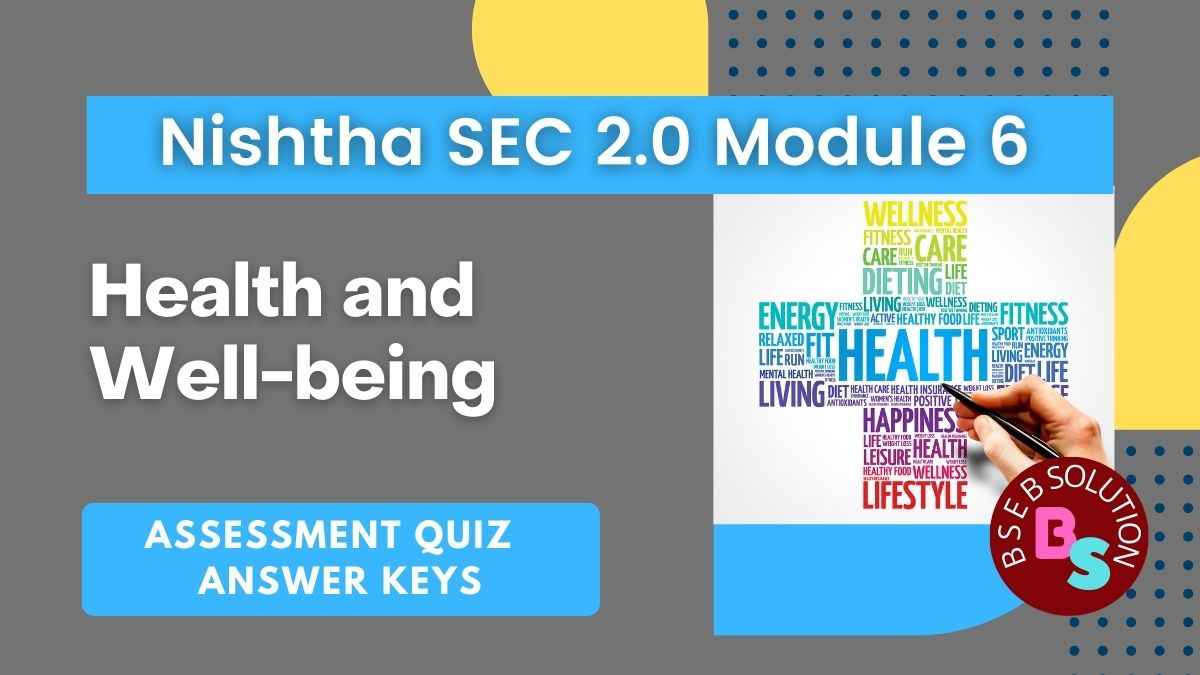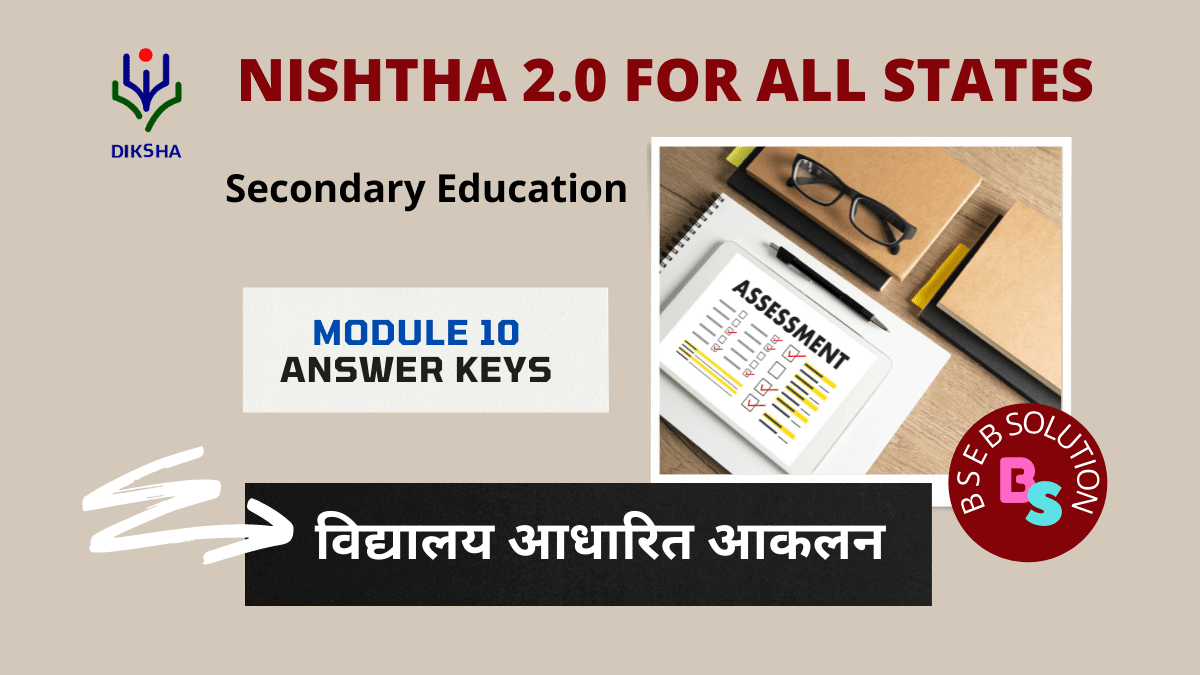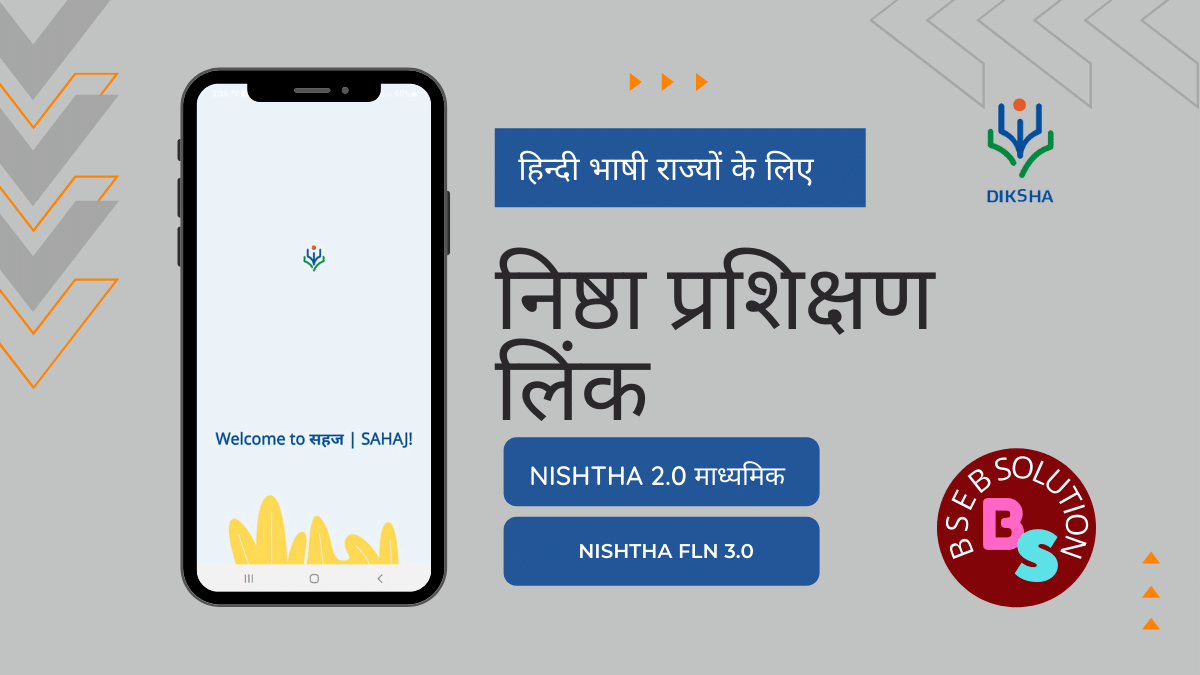Growing up healthy is a conscious effort towards making physical, social, emotional and spiritual well-being a priority among individuals especially belonging to the age group of adolescence which is a phase of tremendous energetic, possibilities and potential. This course is a step forward. In this post you will be able to know “Health and Well-being” UP, BH, HR, MP, CG, JK, UK, RJ, MH, AP, GJ etc. Nishtha SEC 2.0 Module 6 Quiz Answer Key PDF in English for Secondary School Teachers of all states. If you want this questionnaire in Hindi, click here.
“Health and Well-being” Nishtha SEC 2.0 Module 6
The assessment questionnaire of Nishtha 2.0 and 3.0 training is the same in all states, but the Training Links are different. Out of around 40 questions, you will get only 20 random questions in an attempt. You will be able to get the certificate by scoring 70% marks in maximum three attempts.
All the Nishtha trainings available on Diksha App are design to improve teacher performance. So, take all the training seriously and solve the assessment quiz at the end. Certificate will issued only after securing 70% marks in the evaluation quiz. If you face any kind of problem in solving Nishtha SEC 2.0 Module 6 Quiz then get complete solution here.
Nishtha SEC 2.0 Module 6 Answer Key
Q. Anaerobic exercise is a..
(1). Low intensity activity for a short period of time
(2). Low intensity activity for a long period of time
(3). High intensity activity for a long period of time
(4). High intensity activity for a short period of time (✓)
Q. What is the chain of 5 F’s that can cause infection?
(1). Food, fingers, flies, faeces, fields.
(2). Faeces, fluid, fingers, flies, fields (✓)
(3). Food, fruits, flies, finger, fields
(4). Fluid, fingers, flies, fields, fruits
Q. What is violence
(1). Any emotional harm caused to another. person against whom the act is directed.
(2). Any physical harm caused to another person against whom the act is directed
(3). Any mental and sexual harm caused to another person against whom the act is directed.
(4). Any physical, emotional, mental, & sexual caused to another person against whom the act is directed (✓)
Q. How much should a person at least play any game per day after warming up to stay fit?
(1). 60 minutes
(2). 80 minutes
(3). 15 minutes
(4). 30 minutes (✓)
Q. What are the various mode of transmission of communicable disease?
(1). Droplet infection
(2). Contact the soil
(3). Direct transmission, Droplet infection, contact with soil (✓)
(4). Direct transmission, indirect transmission
Q. Health related fitness do not include –
(1). Cardiovascular fitness
(2). Flexibility
(3). Balance (✓)
(4). Muscular Endurance
Q. How does food ensure the proper nutrition and function of our body?
(1). By storing energy, it help fight disease and protect the body
(2). Through a balance diet
(3). By building muscles and helping protect the body
(4). By building muscles, protecting the body helping to fight against diseases, storing energy and a balanced diet (✓)
Q. Which of the following helps us in realising our true self?
(1). Yama
(2). Pranayam and Dhyana (✓)
(3). Asana
(4). Pranayama
Q. Ahinsa is one of the principle of
(1) asana
(2) yama (✓)
(3) niyama
(4) pratyahara
Q. Physical activities mainly prevents us from
(1). Cardiovascular disease (✓)
(2).Diabetes
(3). Arthritis
(4). Alzheimer’s
Q. What does ” POCSO” act stand for?
(1). Protection of children from sexual oppression act.
(2) Protection of child against sexual offences act.
(3). Protection of child against sexual oppression act.
(4). Protection of children from sexual offense act. (✓)
Q. Which one is a cardiovascular disease ?
(1). Sickle cell Anaemia
(2). Cystic fibrosis
(3). Marfan syndrome (✓)
(4). Carcinoid Syndrome
Q. ” The first aid for Teachers and Students ” was developed by?
(1). National health authority
(2). Ministry of health anfd family welfare
(3). National disaster management authority (✓)
(4). New delhi municipal corporation
Q. Which of the following things should be avoided in a case of an emergency?
(1) caring for the bleeding, it may be serious
(2) Give them something to eat or drink to avoid discomfort due to hunger or thirst. (✓)
(3) try to find out what happened ; ask, shout to call the sick person.
(4) try to protect an ill or sick person from heat or cold
Q. What are the factor influencing growth and development in adolescence?
(1) economic background of families
(2) psychological and cultural factors
(3) biological, psychosocial, cultural, socioeconomic factors (✓)
(4) Heredity and environment
Q. How can a positive attitude be developed towards healthy relationship in adolescence?
(1) Oblige them to follow our footsteps.
(2) Neglecting them.
(3) Blaming them for unwanted consequences.
(4). Talking to them and Understand their concerns. (✓)
Q. Suryanamaskar improves
(1) blood circulation (✓)
(2) respiration
(3) sleeping pattern
(4) mental health
Q. Daily requirement of physical activities uncludes at least
(1) An hour
(2) 30-40 minutes (✓)
(3) 10 minutes
(4) Less than 10 minutes
Q. Which of the following is involved in respiration of human beings?
(1) Diaphragm
(2) Bladder
(3) Lymph nodes
(4) Muscles of the rib cage (✓)
Q. Which Asan works for increasing height
(1) Katichakrasana
(2) Ardh Matsyendrasana
(3) Vrikshasana (✓)
(4) Makarasana
Q. How our constitution ensures developing sensitivity towards differently abled?
(1) By providing right to live
(2) by providing right to participation
(3) by providing right to equity
(4) By providing right to equality (✓)
Q. Which one of the following is a permanent change in the body that does not occur due to regular physical exercise?
(1). Increase in the number of capillaries.
(2). Increase in the size of the heart.
(3). Increase in the blood cell.
(4). Increase in the abdominal size. (✓)
Q. ……….. refers to the process of being safe online
(1). Cyber safety (✓)
(2). Online safety
(3). SSL certification
(4). Online authenticity verification
Q. The four major sources of media are
(1). Newspaper, magazines, advertisements, television
(2). Television, radio, newspaper, internet (✓)
(3). Online media, offline media, partially online media, mobile applications
(4) News media, mass media, social media, print media
Q. How does the functioning of heart and lungs can be improved
(1) by increasing the availibility of oxygen (✓)
(2) by availability of oxygen and carbon dioxide
(3) By increasing availibility of carbon dioxide
(4) By availibility of oxygen
Q. What is the age group of a adolescents?
(1) 11-21 year’s
(2) 10-19 years (✓)
(3) 11-20 years
(4) 10-18 years
Q. How can a positive attitude be developed towards healthy relationship in adolescence?
(1) Oblige them to follow our footsteps.
(2) Neglecting them.
(3) Blaming them for unwanted consequences.
(4). Talking to them and Understand their concerns. (✓)
Q. What are various issues and concerns related to adolescence?
(1) Growth and development, aggression, self pity, peer pressure
(2) Growth and development, self steem and self concept, anxiety and depression, nutritional needs and any kind of harassment (✓)
(3) self esteem, self concept, anxiety, depression, nutrional needs
(4) body shaming, academic stress, relationship stress, inadequate intake (eating disorders)
Q. “ The first aid for Teachers and Students “ was developed by?
(1). National health authority
(2). Ministry of health anfd family welfare
(3). National disaster management authority (✓)
(4). New delhi municipal corporation
Q. Health related fitness do not include –
(1). Cardiovascular fitness
(2). Flexibility
(3). Balance (✓)
(4). Muscular Endurance
Q. Which two principles are considered as tje universal codes of conduct?
(1) Dharana, dhyana
(2) Pratyahara, asana
(3) Pranayam and bandha
(4) Yama and niyama (✓)
Q. Which one of the following is a helpline for children in distress by the ministry of women and child development
(1) CHILDLINE 1999
(2) CHILDLINE 1094
(3) CHILDLINE 1098 (✓)
(4) CHILDLINE 1908
Q. Which of the following yoga practices help in the emotional management?
(1) Asana, Pranayama, Dharana, dhyana
(2) Asana, Pranayama, and bandha
(3) Yama,, naiyama, asana, pranayam, pratyahara (✓)
(4) Yama and niyama
Q. What are various issues and concerns related to adolescence?
(1) Growth and development, aggression, self pity, peer pressure
(2) Growth and development, self steem and self concept, anxiety and depression, nutritional needs and any kind of harassment (✓)
(3) self esteem, self concept, anxiety, depression, nutrional needs
(4) body shaming, academic stress, relationship stress, inadequate intake (eating disorders)
Q. Daily requirement of physical activities uncludes at least
(1) An hour
(2) 30-40 minutes (✓)
(3) 10 minutes
(4) Less than 10 minutes
Q. Which one of the following is a permanent change in the body that does not occur due to regular physical exercise?
(1). Increase in the number of capillaries.
(2). Increase in the size of the heart.
(3). Increase in the blood cell.
(4). Increase in the abdominal size (✓)
Q. HIV is transmitted through which of the following set of activities:
(1) Hugging, eating from the same utensils, Sharing a toilet.
(2) hugging, blood donation, eating from the same utensils
(3) unsafe sex with a HIV postive person, infected needle, infected blood (✓)
(4) blood donation, shaking hands, hugging
Q. What does “VLCPC” stand for
(1) village level child protection communities
(2) village level child protection committes (✓)
(3) village local child protection communities
(4) village level child protection cabinets
Q. Which one is a cardiovascular disease ?
(1). Sickle cell Anaemia
(2). Cystic fibrosis
(3). Marfan syndrome (✓)
(4). Carcinoid Syndrome
Q. What measures can be taken by a person to remain in good heath?
(1) Taking a balanced diet and maintaining good eating habits, personal & food hygiene and sanitation around us (✓)
(2) Maintaining personal & food hygiene and sanitation
(3) Taking a safe and helathy balance diet
(4) Having good eating habit along with a healthy balanced diet
Q. What are the factor influencing growth and development in adolescence?
(1) economic background of families
(2) psychological and cultural factors
(3) biological, psychosocial, cultural, socioeconomic factors (✓)
(4) Heredity and environment
Q. Which of the following thing should be avoided in case of an emergency?
(1) carrying for the bleeding, it may be serious
(2) Try to find out what happend, ask, shout ti call the sick person
(3) try to protect an ill or sick person from heat or cold
(4) give them something to eat or drink to avoid discomfort due to hunger or thirst (✓)
Q. How can good care of children’s overall health be ensured
(1) taking adequate diet, personal hygiene and sanitation
(2) personal hygiene and sanitation, eat healthy, get good sleep
(3) practice hand washing, cover mouth and nose whiie sneezing, eat healthy, get good sleep & rest (✓)
(4) practice hand washing and cover their mouth
Q. What does “ POCSO” act stand for?
(1). Protection of children from sexual oppression act.
(2) Protection of child against sexual offences act.
(3). Protection of child against sexual oppression act.
(4). Protection of children from sexual offense act. (✓)
Q. What are the four main steps that always need to be followed in emergency situation?
(1) safe, evaluate, self heal, seek help
(2) seek help, safe, evaluate,provide first aid
(3) evaluate, seek help, provude first aid, self heal (✓)
(4) safe, evaluate, provide first aid, seek help
Q. How does the functioning of heart and lungs can be improved?
(1) By increasing the availibility of oxygen
(2) by availability of oxygen and carbon dioxide
(3)By increasing availibility of carbon dioxide
(4) by availibility of oxygen (✓)
Q. Which is not considered as an advantage of playing game and sports
(1) improves eyes vision (✓)
(2) helps in preventing of bone and related disorder
(3) strenghtens hearts muscles
(4) reduces hypertension
Q. ……….. Is relatively new media plateform that has revolutionized our world
(1) social media marketing plateform
(2) display marketing plateform
(3) social media
(4) internet (✓)
Q. What are the various mode of transmission of communicable disease?
(1). Droplet infection
(2). Contact the soil
(3). Direct transmission, Droplet infection, contact with soil (✓)
(4). Direct transmission, indirect transmission
We hope that you have found the answer key for Nishtha Secondary 2.0 Module 6 ‘Health and Well-being’ Quiz, which helped you. Read the solutions of the quiz for modules other than “Health and Well-being” Nishtha Module 6 answer key by clicking the button below.
Get here the link of training for all English medium state boards available on Diksha App. In this you will know the list of all the latest training and the last date of the training course.
If you have any suggestions regarding Nishtha 2.0 Secondary Module 6 quiz answer key, please send to us as your suggestions are very important to us..







